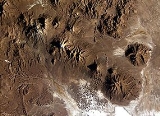
Isluga
Encyclopedia
Isluga is a stratovolcano
located in Colchane
, 7 km west of the Chile
/Bolivia
border and at the west end of a group of volcanoes lined up in an east-west direction, which also includes the volcanoes Cabaray
and Tata Sabaya
. Isluga has an elongated summit area and lies within the borders of Volcán Isluga National Park
.
Stratovolcano
A stratovolcano, also known as a composite volcano, is a tall, conical volcano built up by many layers of hardened lava, tephra, pumice, and volcanic ash. Unlike shield volcanoes, stratovolcanoes are characterized by a steep profile and periodic, explosive eruptions...
located in Colchane
Colchane
Colchane is a Chilean village and commune in Tamarugal Province, Tarapacá Region.The commune is located in the Andean altiplano, bordering Bolivia...
, 7 km west of the Chile
Chile
Chile ,officially the Republic of Chile , is a country in South America occupying a long, narrow coastal strip between the Andes mountains to the east and the Pacific Ocean to the west. It borders Peru to the north, Bolivia to the northeast, Argentina to the east, and the Drake Passage in the far...
/Bolivia
Bolivia
Bolivia officially known as Plurinational State of Bolivia , is a landlocked country in central South America. It is the poorest country in South America...
border and at the west end of a group of volcanoes lined up in an east-west direction, which also includes the volcanoes Cabaray
Cabaray
Cabaray is a stratovolcano in Bolivia. It lies between the volcanoes Isluga and Tata Sabaya, immediately east of the border with Chile....
and Tata Sabaya
Tata Sabaya
Tata Sabaya is a stratovolcano in Bolivia. It is located at the northern end of the Salar de Coipasa, which lies in the Altiplano. It also lies at eastern end of a line of volcanoes starting with Isluga in the west, and continuing with Cabaray. Its last eruption date is unknown, but it is assigned...
. Isluga has an elongated summit area and lies within the borders of Volcán Isluga National Park
Volcán Isluga National Park
Volcán Isluga National Park is located in the Andes, in the Tarapacá Region of Chile, near Colchane and south of Lauca Biosphere Reserve. It covers 1,747 square kilometers, with elevations ranging between 2,100 and 5,550 meters. It is named after Volcán Isluga, which at 5,550 m, is the tallest...
.

